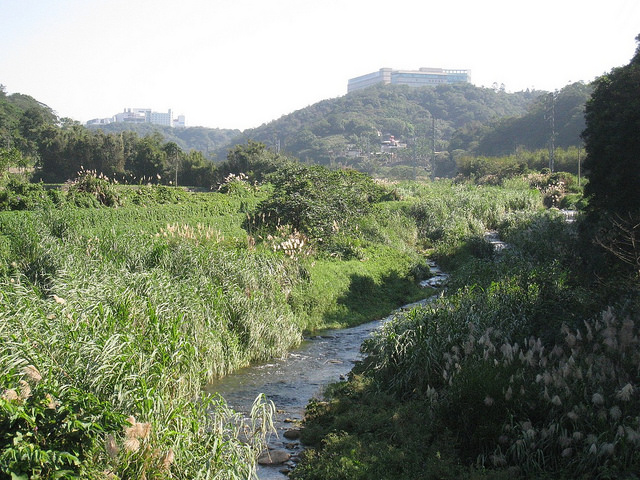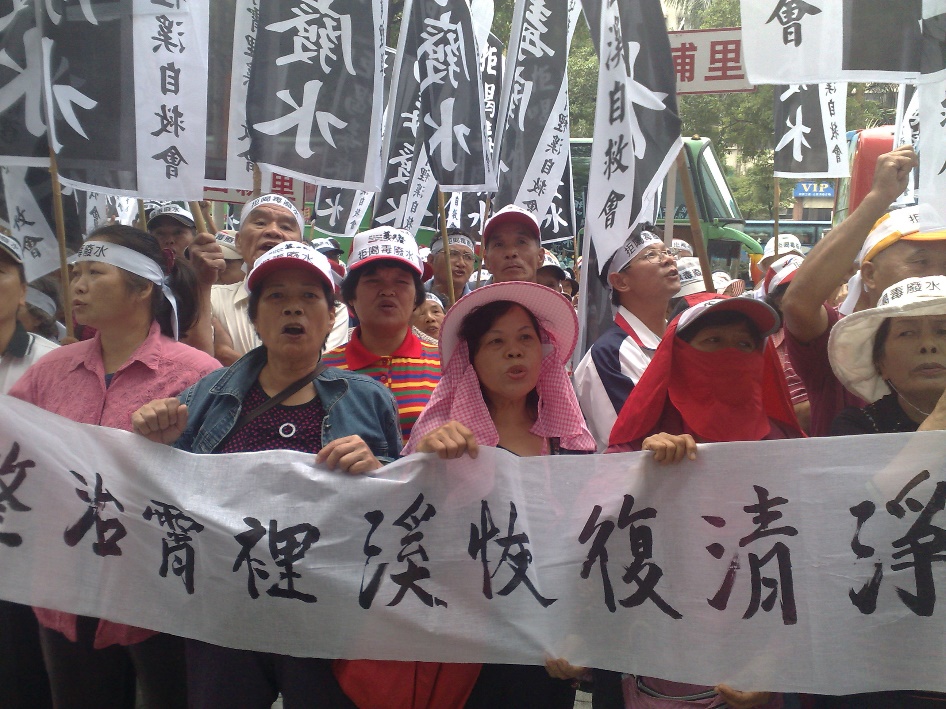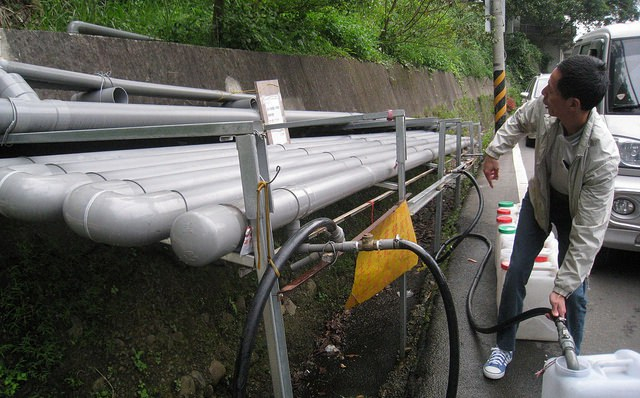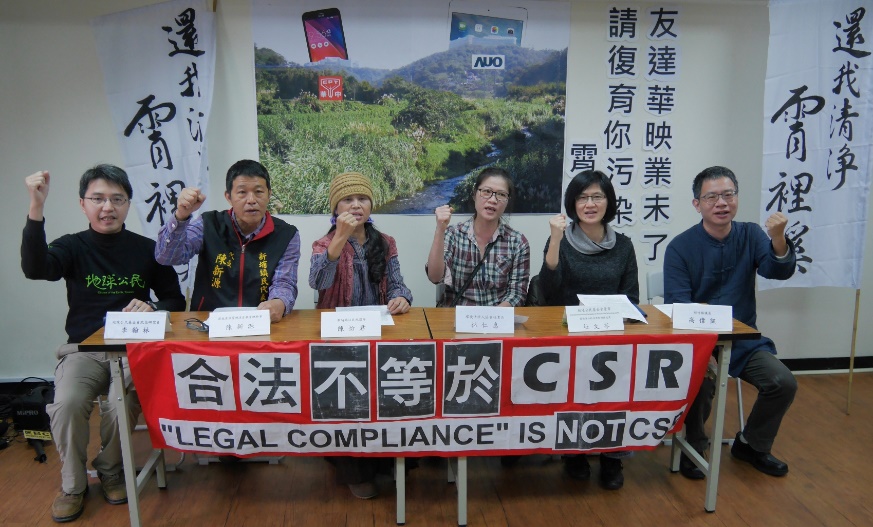Wen-Ling Tu, Professor, Department of Public Administration, National Chengchi University, Taiwan
On December 30, 2015, the AU Optronics (AUO) and Chunghwa Picture Tubes (CPT), two major flat panel TFT-LCD Taiwanese manufacturers held a pipe sealing ceremony, which marked the closing of the sewage discharge pipes and brought them into compliance with the zero-liquid-discharge requirement set by the Environmental Protection Administration (EPA) in 2013. Before the event, two plants, located upstream of the Siaoli River, had discharged wastewater into the river for 16 years. After repeated protests by local residents over the pollution caused by the two plants, the companies finally promised to recycle all their wastewater. In 2017, a year after implementing “zero liquid discharge plan,” the ecosystem of the river has been gradually restored.
The Siaoli River pollution controversies thus underscore the local relentless efforts to hold high-tech firms and the government accountable. In the same vein, the social mobilization drove the companies to find an innovative solution that ended the environmental disputes while saved firms’ production cost. The case demonstrates that the IT firms have the capabilities to advance their environmental practices, however, only with enough pressure from the social demand.

The clean river polluted by high-tech discharge
Siaoli River is 16 kilometers in length. It originates in Taoyuan County and flows into Hsinchu County at midstream where it eventually merges with the Fongshan River. In 2001, AUO and CPT set up their large-scale manufacturing facilities and started operation near the head of the Siaoli River. Since then, these two manufacturers had discharged approximately 40,000 tons of wastewater directly into the Siaoli River on a daily basis, which destroyed the river’s water quality and decimated its life-supporting role for the region.
The Siaoli River pollution incident galvanized local concern after a sudden massive fish population crash in 2003 and the decimation of farmed variegated carp in 2006. The residents accused the two high-tech manufacturers for their effluent discharge that “has caused both air and water pollution, decimated the local ecology, wiped out the fish and shellfish population, and created a fear for people to consume local grown crops due to significant toxicity.”[1] The local residents also protested against the permanent foul stench near the factories.

However, the issue did not receive nationwide attention until the end of 2007, when local citizens filed a law suit against the manufacturers for violation against public safety and appealed to the Taiwanese Control Yuan to impeach the officials that refuse to hold the manufacturers accountable. Both the criminal prosecution and the corrective measures issued by the Control Yuan invalidated the administration’s flimsy claim that the manufacturers did not violate national standards.
Local civic groups accused the two firms of irresponsible wastewater discharges that created water safety issues, as the Taiwan Water Corporation has supplied 36,000 residents in Hsinpu Township with water taken at the convergence of the Siaoli and Fongshan rivers. Some local residents reported that contact with the river water caused undiagnosed skin disorders. Some farmers worried about high electric conductivity in the water, as approximately 1,500 hectares of rice fields are irrigated with the river’s water, which may lead to soil salinization.
The citizens’ concerns forced the Hsinchu Irrigation Association to investigate the water quality of Siaoli River, the result of which found that the conductivity, chloride, sulfate, ammonia, nitrogen, and sodium levels all exceeded the irrigation water quality standard. The investigation report further found the two flat panel manufacturers responsible for the pollution. Samples in this area indicated an absence of plant life, with especially low levels of algal life. The evidence demonstrated that water quality near the wastewater discharge points are dangerously poor, despite their transparent or clean appearances. The investigation results echoed a farmer’s experiences, who stated in his interview that “I used to channel the water from the Siaoli River… I knew that there must be something wrong in the water after the crop started to grow extremely tall but could not bear rice…. Nothing can survive in the water discharged from these two firms.”[2] The rice farmer left the land fallow to prevent further damage on his farmland and human health.
Ironically, the Siaoli River was one of the rare rivers in Taiwan classified as having a high water quality, and has long been the main source of drinking and irrigation water for local communities. The local residents still remember how the water of Siaoli River was once clean enough for direct consumption. The rice fields along the Siaoli riverbanks were also once recognized as one of the three best rice growing areas in the Hsinchu region.
Although two electronics manufacturers denied any wrongdoing and claimed that there was no legal violation, their wastewater emissions have been proven to be toxic, ecologically destructive, and even failed to meet the irrigation water standards. The EPA then held environmental impact assessment (EIA) meetings to discuss the pollution issues and seek solutions. However, whether there were actual legal violations or negative impacts to human health and the environment remained in debate.
Legal compliance and manipulation of risk assessment
While the local Environmental Protection Bureau (EPB) claimed that most records met effluent standards with only few disconformities, the real risks brought by high-tech manufacturing pollutants were put in doubt. The main questions such as who should be responsible for issuing the permits for two firms’ site selection and wastewater discharge soon escaped public scrutiny. Part of reason is that the scope of the risk discussions continued to narrow under the institutional process. The large-scale air and water pollution incidents, ecological catastrophe, and farmland pollution problems were finally minimized by the EPA and the expert committees into a “drinking water” problem.
In 2008, the EPA examined the underground water along the Siaoli River and found rare toxins such as Indium and Molybdenum. The EPA then issued an official notice requesting the Hsinchu County government to advice the local people not to directly use the water in the Siaoli River. Following this unusual notice, the EPA began to truck in water for the residents of Hsinpu Township.

In 2009, following two expert meetings to assess and discuss the health risks of using the underground water along the Siaoli River and two more expert consultation meetings to discuss adding “molybdenum” and “indium” as controlled substances to the drinking water quality control standards, the EPA officially listed indium and molybdenum as controlled substances for drinking water.[3] In December 2009, the EPA declared that “the environmental agency has completed the groundwater investigation along the Siaoli River and found that all test results have conformed to the drinking water standards.”[4] Although molybdenum and indium were detected in some wells, the EPA stated that the concentration levels (27 ur/L for indium and 1.38 ur/L for molybdenum) are far below the newly set standard (70 ur/L) and thus cause no health concerns. Because the expert meetings found no health risk, the EPA ceased trucking in drinking water for the local residents. By narrowing the risk problems to a very limited scope and manipulating the risk assessment procedures, the governmental agencies tended to downplay the problems, while CPT and AUO was able to claim that their wastewater has met or exceeded the national effluent standards.
Regulatory failure and policy connivance
Receiving tremendous pressure from local residents and environmental groups, the companies proposed to relocate their drainage point from the pristine Siaoli River (under the jurisdiction of Hsinchu County) to Laochien River (under the jurisdiction of Taoyuan County), which is already classified as “seriously polluted” water body. On May 13, 2009, the EIA committees adopted the proposal in its 177th General Assembly Meeting. While the Laochien River case has not yet been implemented, people in Taoyuan County moved to oppose the proposal to relocate the discharge point. Taoyuan County Government then held an expert meeting to discuss the case and reject the EPA approved relocation plan. Controversies grew as the relocation plan galvanized contentious mobilization by local citizens from the two counties.
On December 15, 2010, the country’s wastewater control requirements for the optoelectronics industry listed gallium, indium, and molybdenum as a control substances in response to the Siaoli River incident. The EPA claimed that Taiwan became the first nation to enforce restrictions on these three substances in wastewater, as well as on levels of total toxic organics (TTO) and the degree of acute organism toxicity (TUa) permissible. However, the environmental agency did not develop an overall strategy to assess and control all toxic substances used by the industry.
In 2012, under pressure of whether to renew the permit for AUO’s wastewater discharge, the Taiwan Water Company (under the Ministry of Economic Affairs) declared that the Siaoli River shall no longer serve as a source of drinking water. The EPA then declared that the Siaoli River wastewater discharge does not violate the law because the river is no longer a source of drinking water. By removing the Siaoli River from the high quality water list, the government found justification to issue the wastewater emission permits for the companies. Citizen of the Earth, Taiwan criticized the administrative malfeasance which sought to find the most convenient way to legalize the pollution discharge.

With significant pressure from the local communities and environmental groups, the AUO finally announced its “Zero Liquid Discharge Solution” plan in 2013 to resolve the wastewater discharge disputes at roots. They claim that they have made technological breakthroughs and devised a financially feasible solution after years of research and development.
Relentless citizen actions propel CSR
“Zero-liquid-discharge” is the first step for Taiwanese high-tech firms to demonstrate their capabilities to implement their corporate social responsibility (CSR). However, it is a basic requirement internationally for a corporation to internalize its environmental cost and safeguard the right to healthy communities and a safe environment. In 2015, over 200 civil society groups from 40 countries across the globe endorsed the report entitled “Challenge to the Global Electronics Industry” that asked the electronics industry to improve their act on chemicals management during production. The “Challenge” emphasizes the importance of disclosure, substitution of hazardous chemicals, protection of workers, freedom of association, participation of workers, environmental protection, and compensation of workers, communities and the environment. The report has been further recognized by United Nations Industrial Development Organization and the Strategic Approach to International Chemicals Management (SAICM).
The unpleasant Siaoli River pollution incident shows the great potential of the high-tech industry in advancing their environmental performance. The communities and the environment can be free from harm caused by the IT industry if the companies are willing to take innovative initiatives to protect the environment. Of course, the story also tells us the CSR won’t be automatically taken place without persistent environmental activism.
Photos provided by Citizen of the Earth, Taiwan
[1] China Times, May 12, 2006. “Angry at the destruction of the ecology by factories’ effluent, Longtan residents threw fish carcasses at the CPT to protest” C2 Edition.
[2] Special report by “Our Island” of Taiwan Broadcasting System (TBS) on 2008.07.11, “Return Back My Clean Siaoli River.”
[3] Taiwan Environmental Protection Administration. 2009. “Environmental Protection Administration Department of Environmental Sanitation & Toxic Substance Document No.0980016334” EPA, Taipei.
[4] Taiwan Environmental Protection Administration. 2009. “Environmental Protection Administration Department of Environmental Sanitation & Toxic Substance Document No.0980031132” EPA, Taipei.
